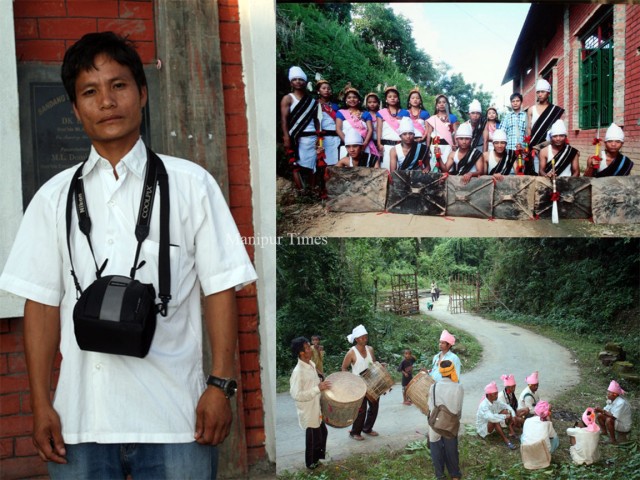Indigenous tribal culture and tradition are losing its significance in today’s modern society as almost all the tribal people have embraced Christianity in Manipur. People have started forgetting indigenous culture and tradition and neglecting folk culture, art, rites and rituals. Maring tribe is among many tribal communities whose indigenous culture and tradition are gradually taken over by modern western culture.
At this critical juncture, Maring youth KP Angphong has been relentlessly working to protect and promote the dying Maring folk culture on his own. With setting up of Kulbi Shong Shong Tribal Cultural Centre, KP Angphom Maring has been teaching Maring folk culture, dance and theatre to Maring boys and girls though he does not get any support from the government.
Hailing from Sandang Senba Maring Village in Senapati district, KP Angphom Maring is the son of KP Leidong, a farmer by profession.
PROTECTION OF INDIGENOUS CULTURE
KP Angphom Maring has choreographed various cultural dances relating to Maring culture, art and tradition including the famous Lousha (Maring war dance), Uiring, Khonloi dances which were performed by Maring forefathers to celebrate inauguration of new houses. He also teaches Nunglui, a rare dance which is performed every five years, Lamlainu (harvesting dance) and Yuilamwa.
Angphong, who inherited the knowledge of Maring culture from his father Leidong, a Maring folk artiste, could realize his dream in the field of Maring folk culture and theatre only after he met theatre director Thanil Leima of Khenjonglang, a popular theatre group in the state. The theatre director, who was once inspired to produce plays, based on Maring folk tales, gave training on theatre to Angphong.
An Arts graduate from United College, Chandel, Angphong used to work in pamlou (field) to support his family though he loved Maring art and culture since childhood.
With 15 artistes, Angphong is running his theatre group, Kulbi Shong Shong Tribal Cultural Centre with local support with the objective of promoting and preserving the dying Maring folk dance, folk song and folk drama. Recently, his theatre group has successfully produced a play entitled, Kulbi Shong Shong, which depicts the history and origin of Maring community.
Regarding the theme of his new folk drama production, Angphong said, “According to a belief of Maring people, Marings first originated from Nungmuisho (cave or underneath the earth), and life underneath the Earth or cave was terribly difficult and hard. They could not come out of the cave as a big stone called “Lungthung” blocked the gate of the cave. Despite efforts to open the Lungthung (stone gate) by sending animals like pig, cow and buffalo to push open the strongly sealed stone gate, they could not open the gate. The flattened nose of pig and the crack marks on buffalo’s horns are believed to have received while trying to push open the stone gate.
Having failed in their efforts to push open the gate using various animals, the Marings finally sent a Shirimpa Bungrang (a black male Mithun). This animal opened the stone gate at last. When the stone gate was opened by the Mithun, the Marings, who were struggling to set free themselves from the terrible and hard life inside the cave or underneath the Earth, could finally come out of the cave and began their first settlement on the Earth at Kulbi-Shongshong, a place which is believed to be located at Kabaw valley of Myanmar. From Kulvi-Shongshong, Maring people gradually scattered to different directions and established many villages, Angphong said.
All these stories are depicted in his newly produced folk drama Khulbi Shong Shong, he added.
Mithun, which could push open the stone gate, is still considered as the only accepted animal for important rituals and ceremonies of Maring people.
He said that Maring tribe is a small tribal group settling in Manipur. The word Maring is derived from Mei (fire) and Ring (to start or produce fire). As almost all the Maring people have embraced Christanity, Maring folk art and culture are being ignored.
He added, “The young generation has forgotten our indigenous Maring folk culture, art and tradition. Disappearance of indigenous culture from Maring society is tantamount to losing of Maring identity. Although we have embraced Christianity, preservation of indigenous folk culture and tradition is the need of the hour to safeguard Maring identity”.
“Without any financial assistance or grants from the government, I have been endeavoring to promote the dying Maring folk culture, folk dance, folk song and theatre art by running a cultural centre on my own. When we are invited for a cultural show outside the state, we raise fund through contribution among the artistes. So far, we have shown varied Maring cultural dances and folk dramas outside Manipur”, he said.
HIS DREAM
“We hire the local community hall of Sandang Senba Maring village as we do not have our own auditorium where the artistes can freely do rehearsals for dance and folk dramas. For construction of a hall, I have approached the village chief to offer land where a big hall can be constructed. The village chief has shown willingness to my request. However, lack of fund has hindered my dream of constructing a hall of the cultural centre. If government provides me some fund, my dream of constructing the hall would be materialized”, he said.












